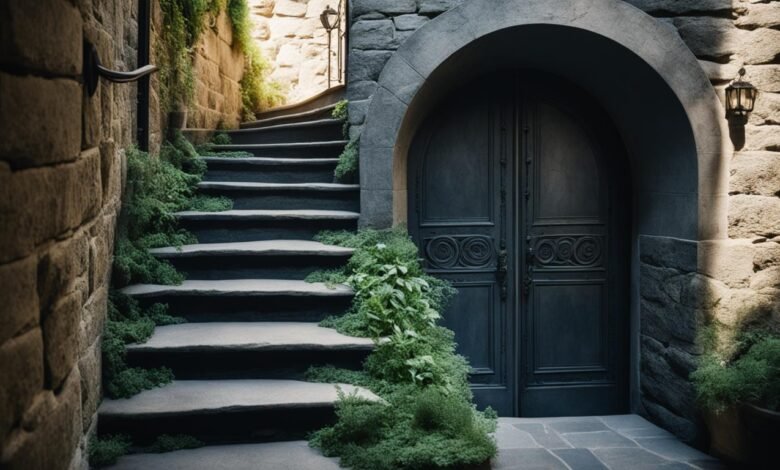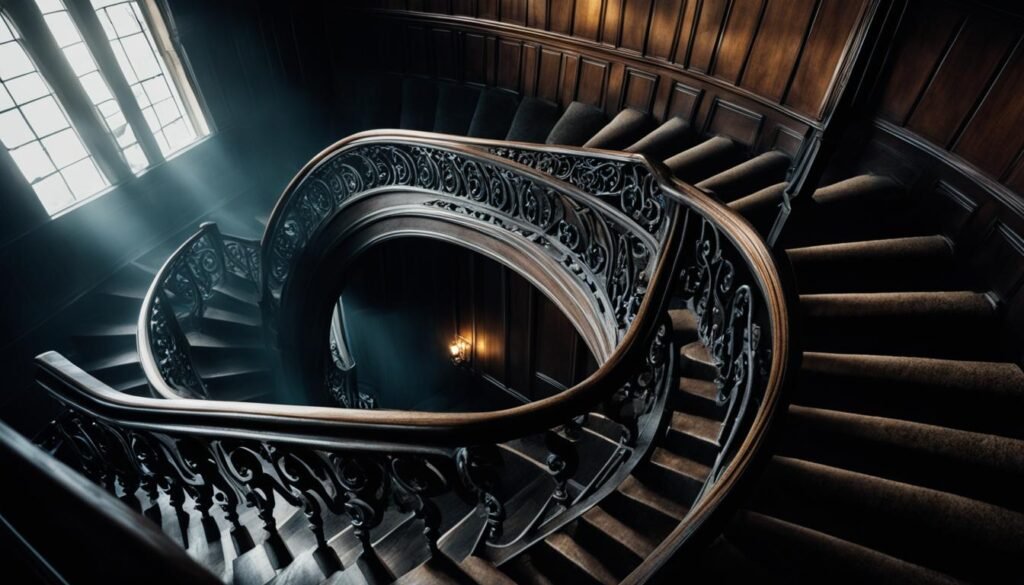Discover the Mystery of Witches Stairs in Your Home

Historic homes often hide a fascinating feature called “witches stairs.” These unique staircases have a zig-zag pattern. Also known as alternating tread stairs, they showcase early American architectural creativity.
Witches stairs are common in New England. Their steep incline and alternating treads make them stand out. They’ve captured the imagination of homeowners and design lovers for years.
Despite their magical name, witches stairs have practical origins. They save space in small, colonial-era homes. The design reduces the horizontal area needed for a traditional staircase.
However, these stairs can be challenging for some. Young children, older adults, and those with mobility issues may struggle. The steep incline and narrow treads can be hard to navigate.
Key Takeaways
- Witches stairs, also known as alternating tread stairs, are a unique staircase design found in some older homes, particularly in the New England region.
- These stairs feature a zig-zag pattern with each step offset to the left or right, creating a steep incline without requiring a large horizontal space.
- The “witches stairs” moniker has been debunked, but these unique stairways continue to captivate homeowners and architectural enthusiasts alike.
- Witches stairs were once believed to confuse or trap witches, preventing them from easily climbing the stairs.
- While practical for small spaces, witches stairs may not be suitable for homes with young children, elderly individuals, or those with mobility issues.
What are Witches Stairs?
“Witches stairs” have captured people’s interest recently. These unique steps feature a zig-zag pattern. They create a steep incline without needing much horizontal space.
Also known as alternating tread stairs, they offset each step left or right. This design allows for a compact, space-saving solution in small homes.
Explaining the Unique Staircase Design
The alternating tread design originated in late 17th-century New England. This was during the Salem witch trials era. However, the idea of trapping witches is a myth.
The true purpose was practical: saving space in small homes. The compact design allowed for steep stairs in tight spaces.
Origins and Beliefs Surrounding Witches Stairs
The term “witches stairs” gained popularity in the 20th century. This was due to persistent superstitions about witchcraft. The idea that witches couldn’t climb these stairs is false.
Despite this, the fascination with this design continues. It shows how folklore can capture our imagination and spark curiosity.
“The claim that alternate-tread stairs were built in old homes to confuse or trap witches has been circulated online multiple times since March 2021.”
In reality, witches stairs were not designed to trap witches. They were a practical solution for small homes. Their unique design has sparked myths and captured public interest.
The Allure of Secret Spaces
Old homes often hide secret spaces that spark our imagination. These hidden features, like witches stairs, reveal rich histories and untold stories. They add mystery and charm to a house’s appeal.
Hidden Rooms and Tunnels in Old Homes
The House of the Seven Gables in Salem has a secret staircase. It was added in the early 20th century, not part of the original design.
A 1910 Boston Sunday Globe article reported on secret staircases’ popularity. It mentioned a hidden stairway in Governor Tilden’s mansion that made headlines in 1905.
The House of the Seven Gables’ secret staircase has many stories. People linked it to smuggling, tax evasion, the Underground Railroad, and witchcraft trials.
Over time, views on this feature changed. It’s now seen as a 20th-century addition, not a historical element.
The Winchester Mystery House in California is another intriguing example. It has 160 rooms, many added during ongoing construction until 1922.
Recently, some hidden areas opened to the public. Visitors can now explore the home’s secret spaces and hidden rooms.
Underground spaces and mystical architecture continue to fascinate people. They reveal the rich stories woven into a home’s very walls.
witches stairs in American Architecture
Witches stairs have a unique design in American homes. They’re also called alternate-tread or Jefferson stairs. These staircases have an interesting history linked to folklore and occult beliefs.
Ancient legends say witches stairs confused witches. This design stopped them from easily climbing up. Over time, the mystical origins faded away.
Now, people appreciate their space-saving and cost-effective construction. These features have kept witches stairs in use for centuries.
Historical Examples of Witches Stairs
Witches stairs are found in many historical American buildings. They were common in colonial-era New England architecture. People believed these stairs could ward off supernatural threats.
| Location | Notable Example | Architectural Style |
|---|---|---|
| Salem, Massachusetts | The House of the Seven Gables | Colonial |
| Boston, Massachusetts | The Paul Revere House | Colonial |
| Wilmington, Delaware | The Hagley Museum and Library | Industrial |
These examples show the lasting appeal of witches stairs. They blend functionality with folklore, captivating those interested in unique architectural features.
“The alternating tread design of witches stairs was thought to baffle witches and deter them from causing harm to the home’s residents, according to ancient beliefs.”
Witches stairs are still used in modern architecture. Their space-saving design and cost-effectiveness make them practical choices. These staircases remain an intriguing part of American architectural history.
The House of the Seven Gables: A Fictional Inspiration
Nathaniel Hawthorne’s House of the Seven Gables has captivated readers with its secret staircases. The original 17th-century house lacked a hidden staircase. However, the 20th-century restoration added one, inspired by Hawthorne’s novel.
The House of the Seven Gables Settlement Association and architect James Everett Chandler made this choice. It reflected the Colonial Revival era’s fascination with enchanted architectural features. The novel’s popularity and the house’s mysterious past led to this addition.
| Key Facts about The House of the Seven Gables | Details |
|---|---|
| Publication Date | April 9th, 1851 |
| Number of Pages | 344 |
| Initial Printings | 6,710 copies across two printings in the first month |
| Critical Reception | The novel was well received upon publication |
| Writing Process | Hawthorne began writing the novel in mid-1850 |
| Pyncheon Family Connection | The Pyncheon family existed and were ancestors of American novelist Thomas Pynchon |
The secret staircase addition shows the lasting impact of Hawthorne’s work. It also highlights the Colonial Revival period’s love for unique architectural elements. This mix of fact and fiction makes the site a fascinating destination.
Visitors can explore the mysteries of the past at this intriguing location. The House of the Seven Gables continues to charm and intrigue those who visit.
“The House of the Seven Gables” by Nathaniel Hawthorne is a captivating work of historical fiction that has inspired generations of readers and architectural enthusiasts alike.
Interpreting the Purpose of Witches Stairs
Witches stairs have sparked many theories over time. Some think they were for smuggling or tax evasion. Others believe they helped the Underground Railroad. These ideas show how our view of history changes.
From Smuggling to the Underground Railroad
One theory suggests witches stairs were used for smuggling. Their tricky design made them hard to climb, perfect for hiding goods.
Historians also think these stairs might have helped the Underground Railroad. They could have been secret escape routes for enslaved people seeking freedom.
Witches stairs still fascinate those interested in hidden stories. They show the cleverness of people who lived in old homes. These unique staircases remain a mystery, adding to their charm.
“The purpose and use of witches stairs have been the subject of much speculation and interpretation over the years.”
Exploring the Mystique of Winding Steps
Spiral staircases are linked to enchanted architectural features. These magical staircases, with their twisting winding steps, evoke a sense of mystical intrigue. They’re often featured in haunted houses and Gothic novels, fueling imaginations with hidden passages.
The magic of spiral staircases has deep roots in history and folklore. In the U.S., these winding steps often had fifteen steps. Older versions had just five or seven steps.
Preston’s Winding Stairs had a unique arrangement of thirty-six steps. They were organized in series of one, three, five, seven, nine, and eleven. Later, the English system removed eleven, leaving twenty-five steps total.
Freemasonry incorporates staircase symbolism into its rituals and teachings. Their stairs are often divided into three categories. This reflects the organization’s preference for odd numbers, especially three, five, and seven.
“The mystery and intrigue surrounding these winding steps continue to fascinate both homeowners and architectural enthusiasts.”
Spiral staircases have captured the imagination of popular culture. Hogwarts Castle’s enchanted steps are a beloved element of the Harry Potter series. They transport readers to a realm of mystical wonder.
Real-world architectural masterpieces also showcase grand winding steps. The staircase at St. Paul’s Cathedral in London is a prime example.

The fascination with winding steps highlights our desire to explore the magical and unknown. These enchanted steps continue to captivate and inspire. They remind us of architecture’s timeless allure and the power of imagination.
Finding Witches Stairs in Your Home
Witches stairs are captivating architectural features found in older homes. These unique zig-zag staircases hint at hidden spaces and stories within walls. Often discovered in historic New England, they spark curiosity about a home’s past.
The original purpose of witches stairs has been debunked. Yet, they still fascinate us with their mystery and historical significance. Homeowners who find these elements glimpse into an era of widespread superstitions.
- The practice of leaving a broomstick across the doorway to deter witches is a common tradition in the American South and the Sea Islands of South Carolina and Georgia.
- Hanging a sieve over the keyhole as a means to stop witches from entering the house until all the holes have been counted was a known protective method against witches.
- Sleeping with a Bible, a silver dollar, or a knife beneath the pillow was recommended to prevent witches from troubling individuals while they sleep.
These staircases may have been designed to confuse unwanted visitors. The zig-zag pattern was thought to disrupt negative energy flow. This design provided a layer of protection for the home’s occupants.
| Protective Measure | Purpose |
|---|---|
| Turning socks inside out | Keeping witches away |
| Scattering mustard seeds around the bed | Deterring witches |
| Hanging a bottle with pins stuck in the cork beside the bed | Warding off witches and evil spirits |
Finding witches stairs in an older home can be thrilling. It offers a peek into the property’s architectural and cultural history. Homeowners exploring hidden nooks might stumble upon these captivating features.
These stairs provide a tangible link to the intriguing past. They remind us of the beliefs and traditions that shaped our homes long ago.
Preserving the Legacy of Witches Stairs
Witches stairs and enchanted architectural features captivate people’s imagination. Preserving these historical elements has become increasingly important. Homeowners and organizations work to maintain these unique staircases for future generations.
Careful restoration and adaptive reuse help safeguard the rich history of these captivating design features. These efforts ensure the enduring appeal of witches stairs and other mystical architectural elements.
Maintaining Enchanted Architecture
Protecting witches stairs and historic architectural gems requires a multi-faceted approach. Homeowners with these enchanted spaces must be diligent in their maintenance and restoration efforts. This often involves delicate repair work and consulting with preservation experts.
Preservation organizations play a crucial role in protecting these architectural wonders. They identify, document, and advocate for the protection of these unique structures.
Studies show that most accused in witch trials were marginalized women living on society’s edge. Preserving physical remnants of this dark history is crucial for understanding the past. It also honors the struggles and resilience of those persecuted.
Ritual protection marks in historic buildings keep stories of the past alive. Haunting tales echo through winding steps, connecting us to our ancestors’ experiences.
“Ritual protection marks can be found in various historic buildings, including churches, castles, cottages, mills, and barns. Burn marks found on exposed timbers were made through a meticulous process, holding a taper at a 45-degree angle for up to 20 minutes.”
The fascination with witches stairs and mystical design features continues to grow. Preservation and education become increasingly vital to protect these architectural gems. This safeguards the past and inspires future generations to appreciate enchanted architecture.
By preserving these unique structures, we honor the historical preservation of old homes. We also ensure the enduring allure of witches stairs for years to come.
Incorporating Witches Stairs in Modern Design
Witches stairs are gaining popularity in contemporary architecture. Designers blend these unique staircases with modern materials and techniques. This fusion preserves their legacy while adapting to current styles.
Alternate-tread stairs are a modern version of traditional witches stairs. These space-saving designs feature half-width treads in a staggered layout. They fit well in tiny homes, lofts, and mezzanines.
These stairs serve a practical purpose and add mystery to interiors. Their spiral configuration and enchanted architecture create a charming atmosphere. They offer both functionality and aesthetic appeal.
Designers blend witches stairs with traditional staircase elements. They incorporate curved handrails, intricate metalwork, and hidden storage. This creates a seamless mix of old and new styles.

Modern interpretations of witches stairs offer unique visual experiences. They allow homeowners to enjoy historic features in contemporary spaces. These staircases become captivating focal points in modern homes.
The growing interest in witches stairs inspires designers to innovate. They create enchanted architecture that transforms ordinary staircases. These designs turn simple stairs into extraordinary works of art.
The Enduring Fascination with Magical Architecture
Magical architecture like witches stairs has enthralled people for centuries. These unique features in historical homes blend mystical elements with design. Homeowners, architects, and enthusiasts are drawn to their enchanting appeal.
Witches stairs and spiral staircases offer a peek into hidden stories. These bewitched features capture the human spirit with their mysterious allure. They represent a fascinating blend of history and magic.
Historical records suggest witches stairs have ancient origins. They were linked to powerful mystical properties. Their spiral design differed from straight staircases, attracting occult practitioners for spellcasting.
In medieval Europe, witches stairs gained notoriety during witch trials. However, these superstitions have faded over time. Today, they hold different meanings in various cultures.
Modern interpretations see witches stairs as symbols of femininity and fertility. Some view them as practical solutions for homes with limited space. Artists and writers draw inspiration from these enchanted design features.
“The magical architecture of witches stairs has captivated our collective imagination for centuries, offering a tantalizing glimpse into the hidden stories and enchanted design that have long captured the human spirit.”
Magical architecture reveals our desire to connect with past mysteries. Witches stairs, spiral staircases, and hidden rooms inspire us. These bewitched features unlock secrets of historical homes.
The enchanted design continues to captivate generations. It invites us to explore the hidden wonders of architectural magic. Our fascination with these spaces endures, bridging past and present.
Witches Stairs: A Bewitching Element of Home Design
Witches stairs are a captivating element of home design. These unique, zig-zag staircases were once believed to confuse or trap witches. Now, they intrigue homeowners and design enthusiasts alike.
Witches stairs offer a glimpse into hidden stories and mystical elements. Their winding steps and hidden nooks create a sense of enchantment. They transform ordinary spaces into magical environments.
Incorporating witches stairs can be a captivating design choice. This architectural element adds unique visual interest to homes. It also reminds us of rich history and folklore.
Witches stairs can lend an air of mystique to any living space. They blend well with Gothic-style homes and modern decor. Homeowners can create truly enchanting spaces with these magical staircases.
| Design Element | Recommended for Witches Stairs |
|---|---|
| Color Palette | Dark, autumnal hues like rich ochre and maroon |
| Furniture | Worn black leather, rich velvets, and deep ruby red fabric |
| Wallpaper | Bold, decorative patterns like intricate paisley or fleur-de-lis |
| Plants | Herbal tea gardens for brewing calming chamomile or healing hibiscus |
Witches stairs blend the mystical and practical in a bewitching way. They create spaces that truly enchant and inspire. Homeowners can embrace their captivating history and unique design.
Conclusion
Witches stairs have long fascinated people, sparking interest in hidden spaces and magical architectural elements. Their origins are now known to be myths. Yet, they still appeal due to their rich history and folklore.
These unique staircases represent our desire to connect with past mysteries. Their zig-zag patterns and winding steps continue to capture our imagination. They inspire appreciation for the hidden stories within our homes.
Witches stairs are found in both historical and modern homes. They showcase the ingenuity and superstition that shaped New England’s architecture. Their charm extends far beyond the region.
These staircases remind us of design’s power to evoke wonder. They highlight our fascination with the unknown. Witches stairs will keep inspiring us, leaving a lasting impact on architectural history.
FAQ
What are witches stairs?
Witches stairs, or alternating tread stairs, have a unique zig-zag pattern. Each step is offset, creating a steep incline in a small space. People once thought this design could confuse witches, stopping them from climbing easily.
What is the origin and purpose of witches stairs?
The “witches stairs” name is a debunked myth. These stairs exist in various historical homes, especially in New England. Their true purpose remains a mystery, sparking ongoing fascination and interpretation.
How are witches stairs related to secret spaces in old homes?
Old homes often have hidden rooms and tunnels that captivate people’s imaginations. Unique staircases like witches stairs can reveal a home’s rich history. They add mystery and appeal for homeowners and architecture fans.
Where can witches stairs be found in American architecture?
Witches stairs have been part of American architecture for centuries, especially in the Northeast. You can find these unique staircases in old homes and buildings across the United States.
How have fictional works like The House of the Seven Gables influenced the fascination with witches stairs?
Nathaniel Hawthorne’s novel sparked interest in secret staircases. The original house didn’t have one, but a 20th-century restoration added it. This reflects growing fascination with enchanted architectural features during the Colonial Revival era.
Why are spiral staircases associated with the mystique of witches stairs?
Spiral staircases share the mystique of witches stairs. Their twisting steps evoke magic and the occult. They capture imaginations with ideas of hidden passages and bewitched ascents.
How can homeowners find witches stairs in their homes?
Homeowners can search for witches stairs in older homes, especially in New England. Look for unique, zig-zag staircase designs. Finding these can be an exciting adventure in architectural discovery.
What efforts are being made to preserve the legacy of witches stairs?
Preserving witches stairs has become increasingly important. Homeowners and organizations work to maintain these unique staircases. They use careful restoration and adaptive reuse to ensure future generations can appreciate them.
How are modern designers incorporating witches stairs into contemporary architecture?
Some modern designers are bringing witches stairs into contemporary architecture. They blend the enchanted aesthetic with modern materials and techniques. This innovative approach brings mystery and magic into present-day designs.





